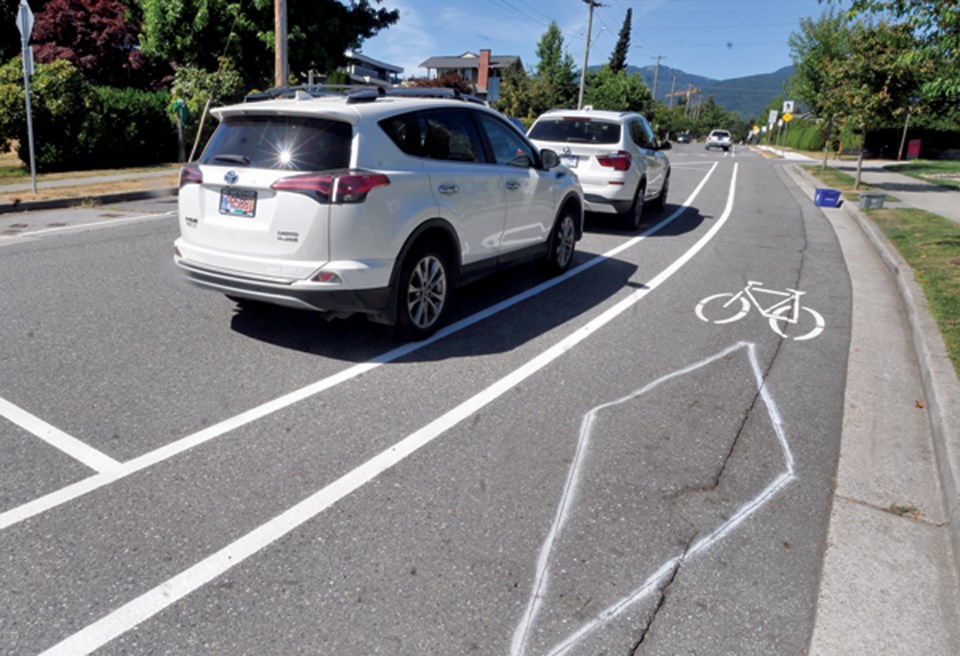An attempt to lower driver speeds along St. Andrews Avenue in North Vancouver is instead raising blood pressures.
The City of North Vancouver, however, says the traffic calming measures between 13th Street and Keith Road are in keeping with international best practices for making the street safer.
Physical changes to the street include moving the northbound parking lane over into the street, making the street narrower and creating room for a new uphill mobility lane for people on bikes. For pedestrians, the city has also added raised crosswalks and curb bulges at intersections to make crossing easier, and installed a new sidewalk on the east side of the street.
Complaints shared with the city since the changes were made in July and August have been manifold: St. Andrews is no longer wide enough for drivers to pass one another without squeezing over; there are fewer street parking spaces; it’s difficult for drivers turning on to St. Andrews to see what’s coming until it’s too late.
“Everyone has to swing really wide and swing into the middle of the road, and the big trucks that are coming down that road can't go anywhere. It's become very dangerous for us,” said Veena Sood, who lives in the neighbourhood..
Because the parking lane is now shunted over from the curb, it means the space becomes even narrower any time anyone exits their vehicle, Sood noted.
Slow your roll
The city considers St. Andrews to be a residential street, but it was built like an arterial and people drive it as such, said Justin Hall, the city’s manager of public realm improvements.
In 2020, the city lowered the St. Andrews speed limit to 30 kilometres per hour, but two years of study found drivers weren’t slowing down.
“People were using it as a cut through route,” Hall said. “This came up as a priority for us to take a look at and try to address the speed and volume. So our objective here with this project is to make the streets safer for everyone.”
Curb to curb, St. Andrews is 12 metres wide, “which is extraordinarily wide for a residential street,” Hall said. “It’s really comfortable for drivers to travel fast, and not really have a sense of how fast they're going, and it’s much too quick for a residential context.”
Narrower streets have been shown to force drivers to slow down, look ahead and better anticipate oncoming traffic, Hall said.
More speed bumps and stop signs could slow traffic down, Hall said, but can also have counterproductive effects. They impact emergency vehicles’ response times and, the more stop signs there are on a street, the more likely drivers are to roll through them, he said.
“With this being a popular walking route to school, that's the worst possible conflict that we could imagine,” he said.
Residents have also asked why there couldn’t be more police presence to slow things down, but Hall said it’s better to prevent unwanted behaviour through design than it is to react to it through enforcement.
“[The RCMP] can't be everywhere at once, and they can't be somewhere all the time,” he said.
Hall said there will be some more minor work done in the week ahead, which will be followed by a period of monitoring and data collection by the city to see whether the desired improvements are being delivered.
But in the interest of managing expectations for those in the neighbourhood, Hall said there are no plans for the city to throw the project into reverse.
“Absolutely expect there will be some tweaks in the days and months to come. The street, as it was previously, was not doing all the things that needed to do for us as a city,” he said. “We anticipate it will take some time to adapt, but these changes will ultimately lead to a safer street for everyone.”
A calming effect
Heather Drugge, a member of the HUB North Shore cycling advocacy group, said she rides St. Andrews almost every day and feels safe when travelling in the new mobility lane.
But she said the same safety benefits could have been achieved with “true traffic calming”– installing barriers every few blocks that physically divert drivers off St. Andrews entirely, similar to Adanac Street in Vancouver.
“I love the new bike lane, but it was not ever what we wanted in the first place,” she said. “Traffic-calmed streets do not require a bike lane.”
Drugge said the project could still be improved upon.
“If the city and the cyclists and the residents can sit down together, we have the same goal, which is traffic calming. It's just how does it get done?” she asked.
Sood said she also found the city’s consultations to be lacking, given the amount of folks who were taken by surprise. A petition at the till at Andrews on Eighth coffee house has racked up more than 400 signatures calling for the changes to be reversed.
“I guess, as a community, we all have to decide: do we want to escalate this or not?” she said.



